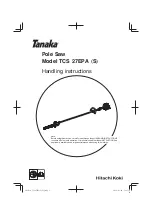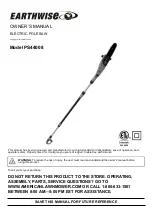
sm1304.V2 | issue 1 20/09/16
Original Language Version
© Jack sealey limited
4.2.
Stand Assembly fig.2b
4.2.1.
Place angle frame (A) top down on floor, attach four legs legs (B)
using the eight bolts supplied.
4.2.2.
Bolt leg cross members (C) as shown in fig2b.
4.2.3.
Push on rubber feet onto bottom of legs, turn stand up correct way.
4.2.4.
Bolt on wheels as shown.
4.2.5.
ensure all bolts are done up tight.
4.2.6.
lift saw on to frame (beware of weight, second person may be required)
Bolt base of saw to frame using four bolts supplied.
5. adjusTMenTs
warninG!
ensure that the bandsaw is disconnected from the power supply before attempting any adjustments.
5.1.
changing the blade
5.1.1.
Turn the blade cover screws counter clockwise (fig.1B) to open the upper and lower blade covers.
5.1.2.
turn blade tension adjustment knob anticlockwise (fig.1A) to slacken the blade.
5.1.3.
remove the blade retaining bracket by undoing the two bolts and removing it. carefully remove the blade.
5.1.4.
Install the new blade. Be sure the teeth are pointing downwards and outwards. Refit the retaining bracket.
5.1.5.
Adjust new blade to the correct tension (see 5.2.) and check, and adjust if necessary, tracking (see 5.3.) and blade guide adjustment
(see 5.5. & 5.6.).
5.1.6.
close both blade covers and screw in bolts.
5.2.
adjusting blade tension.
5.2.1.
open the blade covers and check to ensure that blade is centred on both wheel rims (if not, see section 5.3).
5.2.2.
turn the blade tension knob (fig.1A) to adjust the blade tension - clockwise to tighten, anticlockwise to slacken.
correct tension is reached when the blade gives slightly to firm finger pressure at mid-span. do not over-tighten.
5.2.3.
close both blade covers and lock with blade cover locks.
5.3.
adjusting blade tracking
5.3.1.
open blade covers and carefully rotate the upper blade wheel (fig.3) clockwise by hand, to determine whether blade is tracking
correctly - blade should be on the centre of each wheel rim.
5.3.2.
if adjustment is needed, turn the tracking knob (fig.2.l) whilst continuing to turn the upper blade wheel. note the effect on
the tracking and continue to turn tracking knob until tracking is correct.
5.3.3.
close both blade covers and lock with blade cover locks.
5.4.
upper blade guide position
5.4.1.
the upper blade guide should always be adjusted to about 3mm above the workpiece. to adjust:
turn the adjustment knob (fig.3.c) to lower guide to required position.
5.5.
upper blade guide bearing adjustment
5.5.1.
the upper blade side guides prevent excessive sideways movements of the saw blade. they should be adjusted so that they are just
clear of the saw blade. Adjust the guides (figs.4 & 5A) on both sides. turn the top wheel twice to check correct alignment and that are
correctly positioned, then tighten the locking nuts to secure.
re-check guides for correct positioning.
5.5.2.
the upper blade guide rear bearing prevents the saw blade from being pushed backwards when cutting. it should be adjusted so that
it is just clear of the blade (0.75mm). loosen knob (figs.4 & 5.c) and move the bearing (figs.4d) inwards so that it touches
the blade, then adjust it out slightly to just clear of the saw blade. tighten knob to secure. re-check for correct positioning.
5.5.3.
Knob (fig.4 & 5B) is for adjustment / leveling of bearing housings and can be moved backwards and forwards in conjunction with bearing
(fig4.d).
5.6.
lower blade guide bearing adjustment
5.6.1.
the three lower guides / bearings should be adjusted using the same procedure as for the upper guides / bearings (5.5).
All three guides are more conveniently reached by removing the work table. the two side guides are held in place by allen bolts, the
rear guide is also held in place by an allen bolt.
notes: a) Always check and adjust both upper and lower guides at the same time.
b) carry out these checks/adjustments every time the blade is changed.
c) the blade will be damaged if the teeth contact the guides/guide bearings.
5.7.
Mitre gauge
5.7.1.
the mitre gauge, fits in the slot at the front of the work table, it is adjustable through 45° in either direction. loosen the central locking
knob, adjust and then tighten locking knob.
fig.2b























